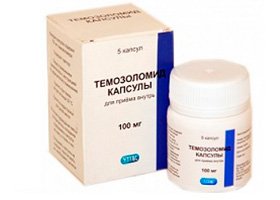
All iLive content is medically reviewed or fact checked to ensure as much factual accuracy as possible.
We have strict sourcing guidelines and only link to reputable media sites, academic research institutions and, whenever possible, medically peer reviewed studies. Note that the numbers in parentheses ([1], [2], etc.) are clickable links to these studies.
If you feel that any of our content is inaccurate, out-of-date, or otherwise questionable, please select it and press Ctrl + Enter.
Temozolomide
Medical expert of the article
Last reviewed: 03.07.2025

Temozolomide has immunosuppressive and antitumor effects.
ATC classification
Active ingredients
Pharmacological group
Pharmachologic effect
Indications Temozolomide
It is used in the treatment of malignant gliomas, as well as in the development of relapses or progression of the disease after the patient has completed a standard course of treatment.
It is also prescribed for the treatment of malignant melanoma, which has a widespread form and against which metastases have developed (as a first-line drug).
Pharmacodynamics
Temozolomide is a drug with alkylating properties that has antitumor effects. The structure of the drug is imidazotetrazine.
Within the circulatory system (at physiological pH values), a rapid chemical transformation of the substance occurs, during which the active component of MTIC is formed. According to some data, the cytotoxicity of this component is caused mainly by alkylation processes of guanine (at the O6-type position), as well as an additional alkylation process (at the N7-type position). It is likely that the resulting cytotoxic damage activates a mechanism during which aberrant reduction of residual methyl occurs.
Pharmacokinetics
When administered orally, the drug is rapidly absorbed from the gastrointestinal tract. Plasma Cmax levels are observed on average 30-90 minutes (at least 20 minutes should pass under any conditions) after taking a single dose of temozolomide. When taken with food, a 33% decrease in Cmax values and a 9% decrease in AUC values were recorded.
The medicinal substance passes through the BBB at high speed and enters the cerebrospinal fluid. Synthesis with intraplasmic protein is 10-20%.
The half-life of the substance from plasma is about 1.8 hours. Excretion occurs at a high rate (mainly through the kidneys).
After 24 hours of oral administration, approximately 5-10% of the dose is recovered in the urine (unchanged drug). The remainder is excreted as 4-amino-5-imidazole carboxamide hydrochloride or unspecified polar degradation products.
Dosing and administration
The capsules should be swallowed whole with water on an empty stomach, 60 minutes before eating.
The initial dose for an adult is 0.2 g/ m2, once a day for 5 consecutive days during a 4-week treatment cycle.
For individuals who have previously undergone chemotherapy, the initial dosage should be reduced to 0.15 g/m2 . It is then increased to the standard 0.2 g/ m2 in the 2nd cycle.
The duration of the therapeutic cycle is selected individually.
Use Temozolomide during pregnancy
The medication should not be used by pregnant or lactating women.
Women and men of childbearing potential must use effective contraception for at least six months after completion of therapy with Temozolomide.
Contraindications
Side effects Temozolomide
Taking the medication may cause the appearance of certain side effects:
- disorders affecting the digestive function: vomiting, anorexia, nausea and abdominal pain, as well as diarrhea and constipation, taste disorders and signs of dyspepsia;
- problems with the central nervous system: headaches, paresthesia, feeling of fatigue or drowsiness and dizziness;
- dermatological signs: alopecia, skin rash or itching;
- respiratory disorders: the appearance of dyspnea;
- disorders of hematopoietic processes: anemia, leukopenia or pancytopenia, as well as thrombocytopenia or neutropenia of the 3rd or 4th degree of severity;
- others: asthenia, chills, fever, feeling of malaise and weight loss.
Storage conditions
Temozolomide must be kept at a temperature of no more than 25°C.
Shelf life
Temozolomide is approved for use for 36 months from the date of manufacture of the therapeutic agent.
 [ 35 ]
[ 35 ]
Application for children
There are no data on the use of the drug in children under 3 years of age with multiform glioblastoma, or in individuals under 18 years of age with malignant melanoma. There is also limited information on the use of the drug in glioma in individuals under 3 years of age.
 [ 36 ], [ 37 ], [ 38 ], [ 39 ]
[ 36 ], [ 37 ], [ 38 ], [ 39 ]
Analogues
Analogues of the drug are the drugs Tezalom, Temomid with Temodal, and also Temozolomide-Teva, Temozolomide-Rus, Temozolomide-TL and Temcital.
 [ 40 ], [ 41 ], [ 42 ], [ 43 ], [ 44 ], [ 45 ]
[ 40 ], [ 41 ], [ 42 ], [ 43 ], [ 44 ], [ 45 ]
Reviews
Temozolomide has demonstrated high efficacy in the treatment of anaplastic astrocytoma. In addition, it is prescribed during and after radiation therapy. The drug is also used in the treatment of newly discovered multiform glioblastoma. Today, the main treatment for people with glioblastoma is a combination of Temozolomide and radiation therapy.
Judging by the reviews, the side effects of the drug are quite mild, because the cumulative toxicity of the drug is quite low. But still, it is advisable to use it only in the presence of registered predictable factors of drug efficacy (the methylation level of the MGMT element has the greatest weight).
Manufacturer
Attention!
To simplify the perception of information, this instruction for use of the drug "Temozolomide" translated and presented in a special form on the basis of the official instructions for medical use of the drug. Before use read the annotation that came directly to medicines.
Description provided for informational purposes and is not a guide to self-healing. The need for this drug, the purpose of the treatment regimen, methods and dose of the drug is determined solely by the attending physician. Self-medication is dangerous for your health.

